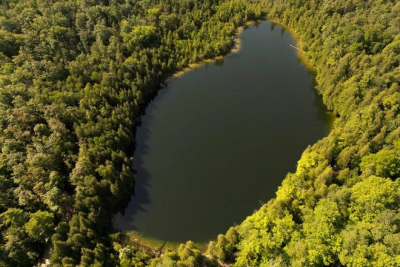What type of lake is Crawford Lake?

Sediment deposited at Crawford Lake in Ontario, Canada, provides solid evidence that Earth entered a new human-driven geological chapter-the Anthropocene epoch- some seven decades ago, a team of scientists said recently. The members of the Anthropocene Working Group plan to submit the evidence to the international scientific body responsible for naming geological chapters in Earth's history. The scientists conducted research at a dozen sites worldwide and cited Crawford Lake as the location that provided particularly persuasive geological markers that the Anthropocene epoch- essentially the age of humans - had arrived in the 1950s.
ANTHROPOCENE - - ETYMOLOGY
The word Anthropocene is derived from the Greek words "anthropo" for "man" and "cene" for "new".
The idea of the Anthropocene was proposed at a science conference more than 20 years ago by the late Nobel Prize-winning chemist Paul Crutzen.
Teams of scientists have debated the issue since then and finally set up the working group to study whether it was needed and, if so, when the epoch would start and where it would be commemorated.
THE LAKE IN CANADA AND THE FINDINGS
From climate change to species loss and pollution, humans have etched their impact on Earth with such strength and permanence since the middle of the 20th century that a special team of scientists says a new geologic epoch began then. Called the Anthropocene, this epoch started sometime between 1950 and 1954, according to the scientists.
While there is evidence worldwide that captures the impact of burning fossil fuels, detonating nuclear weapons and dumping fertilizers and plastics on land and in waterways, the scientists are proposing a small but deep lake outside of Toronto, Canada - Crawford Lake to place a historic marker. "It's quite clear that the scale of change has intensified unbelievably and that has to be human impact," said University of Leicester geologist Colin Waters, who chaired the Anthropocene Working Group.
The scientists aims to determine a specific start date of the Anthropocene by measuring plutonium levels at the bottom of Crawford Lake. The lake which is 79 ft deep and 258,333 sq ft in area was chosen over 11 other sites because the annual effects of human activity on the earth's soil, atmosphere and biology are so clearly preserved in its layers of sediment. That includes everything from nuclear fallout to species-threatening pollution to steadily rising temperatures. There are distinct and multiple signals starting around 1950 in Crawford Lake - showing that "the effects of humans overwhelm the Earth system," said Francine McCarthy, a committee member who specialises in that site as an Earth sciences professor at Brock University in Canada.
'The remarkably preserved annual record of deposition in Crawford Lake is truly amazing," said U.S. National Academies of Sciences President Marcia McNutt, who wasn't part of the - committee. "If you know your Greek tragedies you know power, hubris, and tragedy go hand in hand," said Harvard science historian Naomi Oreskes, a working group member. "If we don't address the harmful aspects of human activities, most obviously disruptive climate change, we are headed for tragedy."
DID YOU KNOW?
Geologists measure time in eons, eras, periods, epochs and ages.
The scientific working group is proposing that Anthropocene epoch followed the Holocene Epoch, which started about 11,700 years ago at the end of the Ice Age.
They are also proposing that it starts a new age, called Crawfordian after the lake chosen as its starting point.
* The reason geologists didn't declare the Anthropocene the start of a bigger and more important time measurement, such as a period, is because the current Quaternary Period, which began nearly 2.6 million years ago, is based on permanent ice on Earth's poles, which still exist. But in a few hundred years, if climate change continues and those disappear, it may be time to change that. AGENCIES
Picture Credit : Google